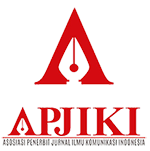DIGITAL HUMAS PEMERINTAH DALAM MENYAMPAIKAN INFORMASI EDUKASI PENCEGAHAN COVID-19 DI INDONESIA
Abstract
This research aims to find out the government's digital public relations in conveying information on Covid-19 prevention education in Indonesia. The concept used is 7-Cs public relations communication, consisting of: credibilty, contex, content, clarity, continuity, and consistency, channels, capability of the audinence. Government public relations, digital public relations, roles and PR models. The paradigm in this study is Constructivist. This type of research is qualitatively descriptive. The method used is a case study. Research findings show the Ministry of Communication and Information, as well as the ministry of SOEs carry out the functions and roles of government public relations by providing messages or information to the Indonesian people related to Covid-19. The role of communicator facilitator runs in the case of Covid-19 where actively and synergistally between institutions convey information to the public, the message is not only conveyed but also adapted to the conditions of the community that will receive the message.
Keywords
Full Text:
PDFReferences
Bungin, B. (2015). Komunikasi Pariwisata. Jakarta : Prenadamedia Group
Butterick, K. (2014). Pengantar Public Relations Teori dan Praktik. Jakarta: Raja Grafindo Persada
Byars, N.. (2012). Government Website. Lee, Mordecai, dkk. (ed). Government Public Relations: What Is It Good For?.on the book of The Practice of Government Public Relations. New York: CRC Press
Creswell, J. W. (2010). Research Design, Pendekatan Kualitatif, Kuantitatif, dan Mixed (cetakan 1) (Penerjemah: Achmad Fawaid). Yogyakarta: Pustaka Pelajar
Creswell, John W., and J. David Creswell. (2018) Research Design-Qualitative, Quantitative, Mixed Methods; 5 th Edition. Sage Publication
Cutlip, S. M., A. H. Center and G. M. Broom, (2011). Effective Public Relations 9th ed, Jakarta:Kencana Prenada Media Group
Denzin, N. K. and Y. S. Lincoln. (2018). Handbook of Qualitative Research. Sage Publication.
Householder, B. (2018).A Mix of Hope and Ambiguity, Deloitte Insights: The Fourth Industrial Revolution is Here, Are You Ready?, pp. 2-4,
Huang, Y. H. C., Wu, F., & Huang, Q. (2017). Does research on digital public relations indicate a paradigm shift? An analysis and critique of recent trends. Telematics and Informatics, 34(7), 13641376. https://doi.org/10.1016/j.tele.2016.08.012
Komodromos, M. and N. Nicoli. (2016) Public relations practitioners view on public relations and digital media: a brief literature review. Int. J. Teaching and Case Studies, 7(1), 42-50. DOI: 10.1504/IJTCS.2016.076038
Lattimore, D., O. Baskin, S. T. Heiman, E. L.Toth. (2010) Public Relation Profesi dan Praktik. Jakarta: Salemba Humanika.
Margaretha L. dan D. M. Sunarya. (2017). Instagram Sebagai Media Sosialisasi 9 Program Unggulan Pemerintah. Jurnal Communication, 8 (2), 88-105. https://journal.budiluhur.ac.id/index.php/comm/article/view/637/0
Meranti, & Irwansyah. (2018). Kajian Humas Digital: Transformasi dan kontribusi Industri 4.0 pada Stratejik Kehumasan. Jurnal Teknologi Informasi Dan Komunikasi, 7(1), 2736. https://doi.org/10.2527/jas 2012-5761
Moleong, L. J. (2010). Metodologi penelitian kualitatif. Bandung : Remaja Rosda karya
Morrar, R., H. Arman, and S. Mousa. (2017).The fourth Industrial Revolution (Industry 4.0) : A Social Innovation Perspective, Technology Innovation Management Review, 1-10
Nurjanah, A dan F. Y. Nurnisya (2016). Pemanfaatan Digital Public Relations (PR) Dalam Sosialisasi Tagline jogja istimewa Humas Pemerintah Kota Yogyakarta. Jurnal Aristo, 4(1), 130-145. http://dx.doi.org/10.24269/ars.v4i1.183
Ruslan, R. (2011). Manajemen Humas & Manajemen Komunikasi: Konsep dan Aplikasi. Jakarta: Rajawali Press.
Sari, N., dan B. Wahyu. (2012). Humas pemerintah. Yogyakarta: Graha Ilmu.
Sugiyono. (2010). Metode Penelitian Kuantitatif, Kualitatif dan R&D. Bandung: Alfabeta.
Yin, R. K. (2016) Qualitative Research from Start to Finish. 2nd ed. New York : The Guilford Press. A Division of Guilford Publications, Inc.
DOI: https://doi.org/10.32509/pustakom.v3i2.1121
Refbacks
- There are currently no refbacks.
Copyright (c) 2020 JURNAL PUSTAKA KOMUNIKASI

This work is licensed under a Creative Commons Attribution-NonCommercial-ShareAlike 4.0 International License.
Indexed by:
Recommended Tools :
Jurnal Pustaka Komunikasi
Fakultas Ilmu Komunikasi, Universitas Prof. Dr. Moestopo (Beragama)
Kampus I, Jl. Hang Lekir I/8 Jakarta Pusat, Indonesia 10270
WA: 085714422271 (Chat Only)
email: pustakom@dsn.moestopo.ac.id
Copyright (c) 2022 Jurnal Pustaka Komunikasi
Licensed under a Creative Commons Attribution-ShareAlike 4.0 International License.













